D-Link DAP-1353 User Manual


Table of Contents
Table of Contents
Product Overview......................................................... |
4 |
Package Contents.................................................... |
4 |
System Requirements.............................................. |
4 |
Introduction............................................................... |
5 |
Features................................................................... |
7 |
Wireless Basics............................................................ |
8 |
Standards-Based Technology.................................. |
9 |
Wireless Installation Considerations...................... |
10 |
Four Operational Modes............................................ |
11 |
Getting Started........................................................... |
12 |
Configuration.............................................................. |
14 |
Home > Basic Settings........................................... |
16 |
Wireless ........................................................... |
16 |
Access Point mode....................................... |
16 |
WDS with AP mode ..................................... |
18 |
WDS mode................................................... |
20 |
Wireless Client mode.................................... |
22 |
Open System/Shared Key authentication..... |
23 |
WPA-Personal authentication....................... |
24 |
WPA-Enterprise authentication..................... |
25 |
LAN ................................................................. |
26 |
Home > Advanced Settings.................................... |
27 |
Performance..................................................... |
27 |
Multi-SSID........................................................ |
29 |
VLAN................................................................ |
31 |
VLAN List...................................................... |
31 |
Port List......................................................... |
32 |
Add/Edit VLAN.............................................. |
33 |
PVID Setting................................................. |
34 |
Intrusion............................................................ |
35 |
Schedule.......................................................... |
36 |
QoS.................................................................. |
37 |
DHCP Server ................................................... |
39 |
Dynamic Pool Settings.................................. |
39 |
Static Pool Setting........................................ |
41 |
Current IP Mapping List................................ |
43 |
Filters................................................................ |
44 |
Wireless MAC ACL....................................... |
44 |
WLAN Partition............................................. |
45 |
Home > Status ...................................................... |
46 |
Device Information........................................... |
46 |
Client Information............................................. |
47 |
WDS Information.............................................. |
48 |
Stats................................................................. |
49 |
Ethernet........................................................ |
49 |
WLAN........................................................... |
50 |
Log................................................................... |
51 |
D-Link DAP-1353 User Manual |
2 |

Table of Contents |
|
View Log....................................................... |
51 |
Log Settings.................................................. |
52 |
Maintenance .......................................................... |
53 |
Administrator Settings...................................... |
53 |
Limit Administrator........................................ |
54 |
System Name Settings................................. |
55 |
Login Settings............................................... |
56 |
Console Settings........................................... |
57 |
SNMP Settings............................................. |
58 |
Firmware and SSL Certification Upload................. |
59 |
Configuration File................................................... |
60 |
Time and Date........................................................ |
61 |
System............................................................. |
62 |
System Settings............................................ |
62 |
Help........................................................................ |
63 |
Troubleshooting......................................................... |
64 |
Networking Basics..................................................... |
66 |
Check your IP address........................................... |
66 |
Statically Assign an IP address.............................. |
67 |
Technical Specifications........................................... |
69 |
D-Link DAP-1353 User Manual |
3 |
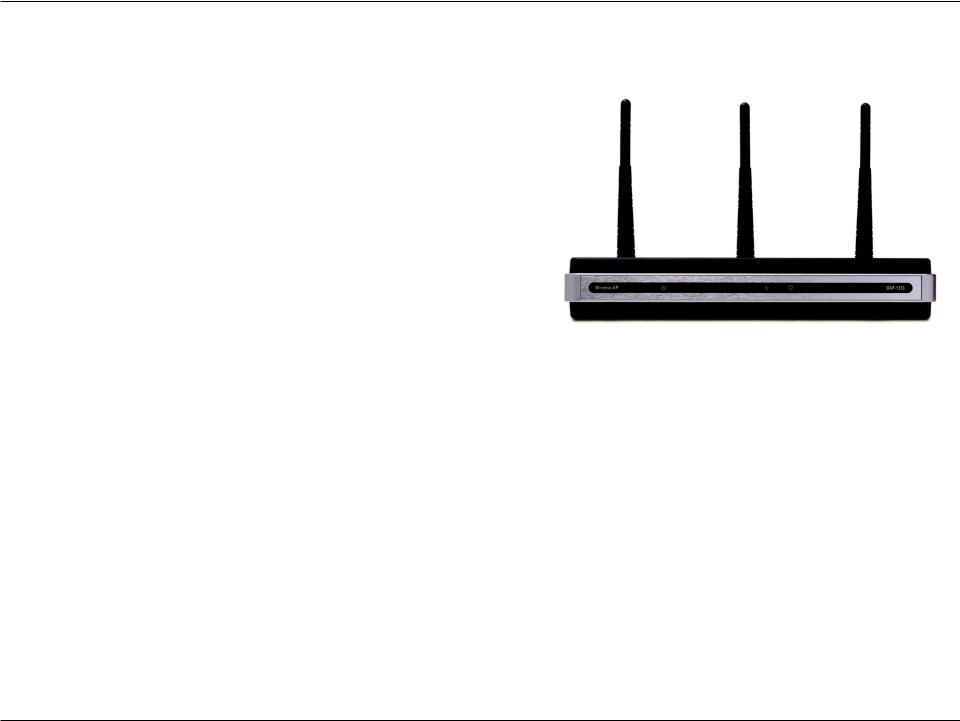
Section 1 - Product Overview
ProductPackageOverviewContents
•D-Link DAP-1353 Wireless N Access Point
•Power Adapter
•CAT5 Ethernet Cable
•CD-ROM with User Manual
•Quick Install Guide
•3 Detachable Antennas
Note: Using a power supply with a different voltage rating than the one included with the DAP-1353 will cause damage and void the warranty for this product.
System Requirements
•Computers with Windows®, Macintosh®, or Linux-based operating systems with an installed Ethernet
Adapter
•Internet Explorer Version 7.0 or Firefox 3.0 and Above (for configuration)
D-Link DAP-1353 User Manual |
4 |

Section 1 - Product Overview
Introduction
The DAP-1353 802.11n 2.4GHZ AP increases productivity by allowing you to work faster and more efficiently. With the DAP-1353, bandwidth-intensive applications like graphics or multimedia will benefit significantly because large files are now able to move across the network quickly.
The DAP-1353 is capable of operating in one of four different wireless networking modes; access point, WDS (Wireless Distribution System) with AP, WDS, or Wireless Client mode.
An ideal solution for quickly creating and extending a wireless local area network (WLAN)inofficesorotherworkplaces, trade shows, and special events, the DAP-1353 providing data transfer rates up to 300Mbps. (The 802.11n standard is backwards compatible with 802.11g, and 802.11b devices.)
WPA/WPA2 is offered in two flavors: Enterprise (used for corporations) and Personal (used for home users).
WPA-Personal and WPA2-Personal are directed towards home users who do not have the server-based equipment required for user authentication. The method of authentication is similar to WEP because you define a “Pre-Shared Key” on the wireless router/AP. Once the pre-shared key is confirmed and satisfied at both the client and access point, access is then granted. The encryption method used is referred to as the Temporal Key Integrity Protocol (TKIP), which offers per-packet dynamic hashing. It also includes an integrity checking feature which ensures that the packets were not tampered with during wireless transmission.
WPA-Enterprise and WPA2-Enterprise are ideal for businesses that already have existing security infrastructures established. Management and security implementation can now be centralized on a server participating on the network. Utilizing 802.1x with a RADIUS (Remote Authentication Dial-in User Service) server, a network administrator can define a list of authorized users who can access the wireless LAN. When attempting to access a wireless LAN with WPA-Enterprise configured, the new client will be requested to enter a username with a password. If the new client is authorized by the administration, and enters the correct username and password, then access is then granted. In the case where an employee leaves the company, the network administrator is able to remove the previous employee from the authorized list to avoid compromising the network.
D-Link DAP-1353 User Manual |
5 |

Section 1 - Product Overview
EAP (Extensible Authentication Protocol) is available through the Windows® XP operating system. You will need to use the same type of EAP protocol on all devices in your network when using the 802.1x feature.
*Maximum wireless signal rate derived from IEEE Standard 802.11 specifications. Actual data throughput may vary. Network conditions and environmental factors, including volume of network traffic, building materials and construction, and network overhead can lower actual data throughout rate.
D-Link DAP-1353 User Manual |
6 |

Section 1 - Product Overview
Features
•Four different operation modes - Capable of operating in one of four different operation modes to meet your wireless networking needs: Access Point, WDS with AP, WDS, or Wireless Client.
•Faster wireless networking with the 802.11n (draft) standard to provide a maximum wireless signal rate of up to 300 Mbps*.
•Compatible with the 802.11b standard to provide a wireless data rate of up to 11 Mbps, allowing you to migrate your system to the 802.11n (draft) and 802.11g standards on your own schedule without sacrificing connectivity.
•Better security with WPA - The DAP-1353 can securely connect wireless clients on the network using WPA (Wi-Fi Protected Access) to provide a much higher level of security for your data and communications than its previous versions.
•AP Manager II management software - The real-time display of the network's topology and AP’s information makes network configuration and management quick and simple.
•SNMP for management - The DAP-1353 is not just fast, but also supports SNMP v.3 for better network management. Superior wireless AP manager software is bundled with the DAP-1353 for network configuration and firmware upgrade. Systems administrators can also set up the DAP-1353 easily with the Web-based configuration. A D-Link D-View 6.0 module will be downloadable for network administration and real-time network traffic monitoring with D-Link D-View 6.0 software.
•Utilizes OFDM technology (Orthogonal Frequency Division Multiplexing).
•Supports one 10/100/1000M Ethernet port.
•Operates in the 2.4~2.5 GHz frequency ranges.
•Web-based interface for managing and configuring.
*Maximum wireless signal rate derived from IEEE Standard 802.11 specifications. Actual data throughput may vary. Network conditions and environmental factors, including volume of network traffic, building materials and construction, and network overhead can lower actual data throughout rate.
D-Link DAP-1353 User Manual |
7 |

Section 2 - Installation
Wireless Basics
D-Link wireless products are based on industry standards to provide high-speed wireless connectivity that is easy to use within your home, business or public access wireless networks. D-Link wireless products provides you with access to the data you want, whenever and wherever you want it. Enjoy the freedom that wireless networking can bring to you.
WLAN use is not only increasing in both home and office environments, but in public areas as well, such as airports, coffeeshopsanduniversities.InnovativewaystoutilizeWLANtechnologyareallowingpeopletoworkandcommunicate more efficiently. Increased mobility and the absence of cabling and other types of fixed infrastructure have proven to be beneficial to many users.
Wireless adapter cards used on laptop and desktop systems support the same protocols as Ethernet adapter cards, allowing wireless users to use the same applications as those used on a wired network.
People use WLAN technology for many different purposes:
Mobility - productivity increases when people can have access to data in any location within the operating range of their
WLAN. Management decisions based on real-time information can significantly improve the efficiency of a worker.
Low implementation costs - WLANs are easy to set up, manage, change and relocate. Networks that frequently change can benefit from WLAN's ease of implementation. WLANs can operate in locations where installation of wiring may be impractical.
Installation and network expansion - by avoiding the complications of troublesome cables, a WLAN system can be fast and easy during installation, especially since it can eliminate the need to pull cable through walls and ceilings. Wireless technology provides more versatility by extending the network beyond the home or office.
Inexpensive solution - wireless network devices are as competitively priced as conventional Ethernet network devices.
The DAP-1353 saves money by providing users with multi-functionality configurable in four different modes.
Scalability - Configurations can be easily changed and range from Peer-to-Peer networks, suitable for a small number of users to larger Infrastructure networks to accommodate hundreds or thousands of users, depending on the number of wireless devices deployed.
D-Link DAP-1353 User Manual |
8 |

Section 2 - Installation
Standards-Based Technology
The DAP-1353 Wireless Access Point utilizes the 802.11b, 802.11g, and 802.11n (draft) standards.
TheIEEE802.11n(draft)standardisanextensionofthe802.11b,and802.1gstandardsthatcamebeforeit.Itincreases the maximum wireless signal rate up to 300 Mbps* within 2.4 GHz bands, utilizing OFDM technology.
This means that in most environments - within the specified range of this device - you will be able to transfer large files quickly, or even watch a movie in MPEG format over your network without noticeable delays. This technology works by transmitting high-speed digital data over a radio wave utilizing OFDM (Orthogonal Frequency Division Multiplexing) technology. OFDM works by splitting the radio signal into multiple smaller sub-signals that are then simultaneously transmitted at different frequencies to the receiver. OFDM reduces the amount of crosstalk (interference) in signal transmissions.
The D-Link DAP-1353 will automatically sense the best possible connection speed to ensure the greatest possible speed and range.
802.11n offers the most advanced network security features available today, including WPA.
*Maximum wireless signal rate derived from IEEE Standard 802.11 specifications. Actual data throughput may vary. Network conditions and environmental factors, including volume of network traffic, building materials and construction, and network overhead can lower actual data throughout rate.
D-Link DAP-1353 User Manual |
9 |

Section 2 - Installation
Wireless Installation Considerations
The D-Link AirPremier N wireless access point lets you access your network using a wireless connection from virtually anywhere within the operating range of your wireless network. Keep in mind, however, that the number, thickness and location of walls, ceilings, or other objects that the wireless signals must pass through, may limit the range. Typical ranges vary depending on the types of materials and background RF (radio frequency) noise in your home or business. The key to maximizing wireless range is to follow these basic guidelines:
1.Keepthenumberofwallsandceilingsbetweentheaccesspointandothernetworkdevicestoaminimum. Each wall or ceiling can reduce your adapter’s range from 3-90 feet (1-30 meters.) Position your devices so that the number of walls or ceilings is minimized.
2.Be aware of the direct line between network devices. A wall that is 1.5 feet thick (.5 meters), at a 45-degree angle appears to be almost 3 feet (1 meter) thick. At a 2-degree angle it looks over 42 feet (14 meters) thick! Position devices so that the signal will travel straight through a wall or ceiling (instead of at an angle) for better reception.
3. Building Materials make a difference. A solid metal door or aluminum studs may have a negative effect on the range. Try to position access points, wireless routers, and computers so that the signal passes throughdrywalloropendoorways.Materialsandobjectssuchasglass,steel,metal,wallswithinsulation, water (fish tanks), mirrors, file cabinets, brick, and concrete will degrade your wireless signal.
4.Keep your product away (at least 3-6 feet or 1-2 meters) from electrical devices or appliances that generate RF noise.
5.If you are using 2.4GHz cordless phones or X-10 (wireless products such as ceiling fans, lights, and home security systems), your wireless connection may degrade dramatically or drop completely. Make sure your 2.4GHz phone base is as far away from your wireless devices as possible. The base transmits a signal even if the phone in not in use.
D-Link DAP-1353 User Manual |
10 |
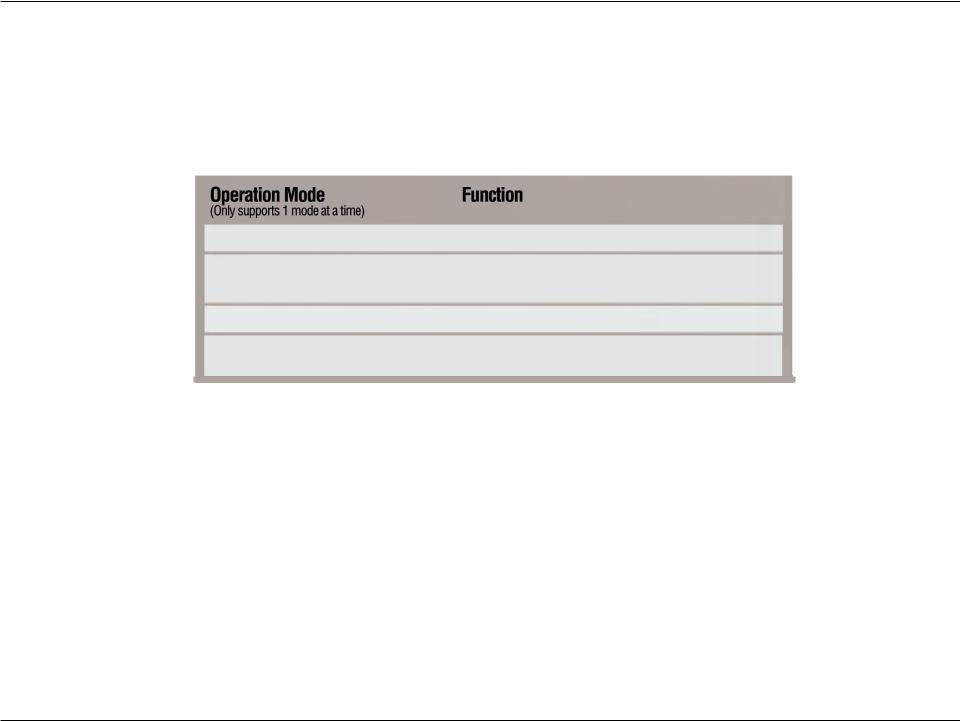
Section 2 - Installation
Four Operational Modes
Access Point (AP)
WDS with AP
WDS
Wireless Client
Create a wireless LAN
Wirelessly connect multiple networks while still functioning as a wireless AP
Wirelessly connect multiple networks
AP acts as a wireless network adapter for your Ethernet-enabled device
D-Link DAP-1353 User Manual |
11 |

Section 2 - Installation
Getting Started
1.You will need broadband Internet access.
2.Consult with your cable or DSL provider for proper installation of the modem.
3.Connect the cable or DSL modem to a router. See the printed Install Guide included with your router.
4.If you are connecting a desktop computer to your network, install a wireless PCI adapter into an available
PCI slot on your desktop computer.
5.Install the drivers for your wireless CardBus adapter into a laptop computer.
D-Link DAP-1353 User Manual |
12 |

Section 2 - Installation
Connect one end of an Ethernet cable (included with your package) to the LAN port on the DAP-1353 and the other end of the Ethernet cable to your computer. The AP can be powered on by the power adapter shipped with the AP.
D-Link DAP-1353 User Manual |
13 |
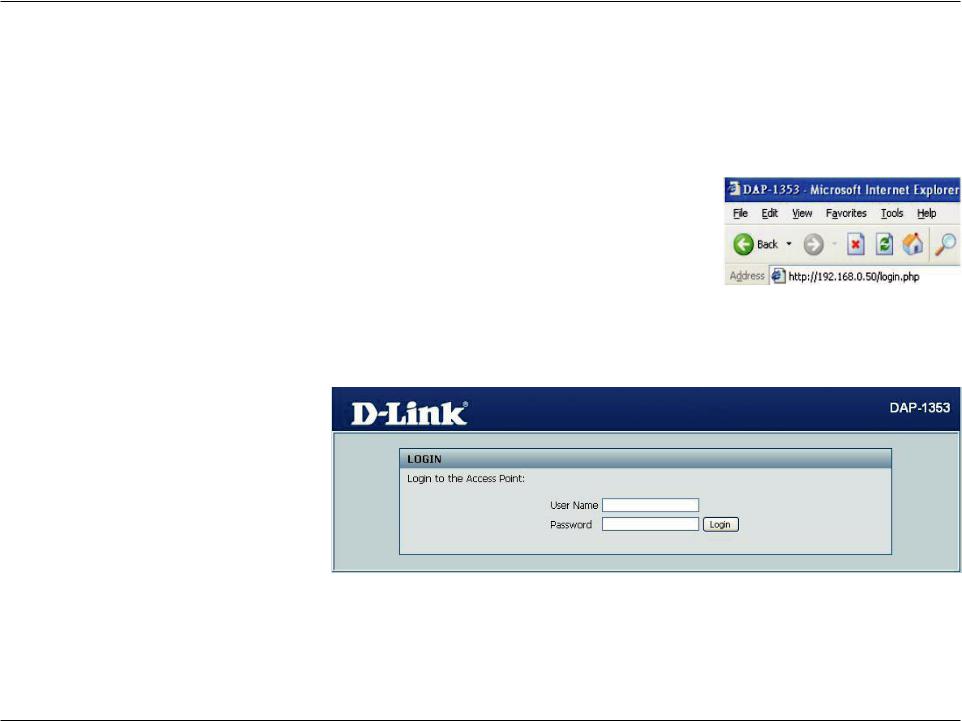
Section 3 - Configuration
Configuration
To configure the DAP-1353, use a computer that is connected to the DAP-1353 with an Ethernet cable (see the Network
Layout diagram).
First, disable the Access the Internet using a proxy server function. To disable this function, go to Control Panel > Internet Options > Connections > LAN Settings and uncheck the enable box.
Start your web browser program (Internet Explorer, Mozilla Firefox).
TypetheIPaddressandhttpportoftheDAP-1353intheaddressfield(http://192.168.0.50) and press Enter. Make sure that the IP addresses of the DAP-1353 and your computer are in the same subnet.
Note: If you have changed the default IP address assigned to the DAP-1353, make sure to enter the correct IP address.
Entertheusername(admin)andyour password. Leave the password field blank by default, and click Login.
Note: If you have changed the password, make sure to enter the correct password.
D-Link DAP-1353 User Manual |
14 |
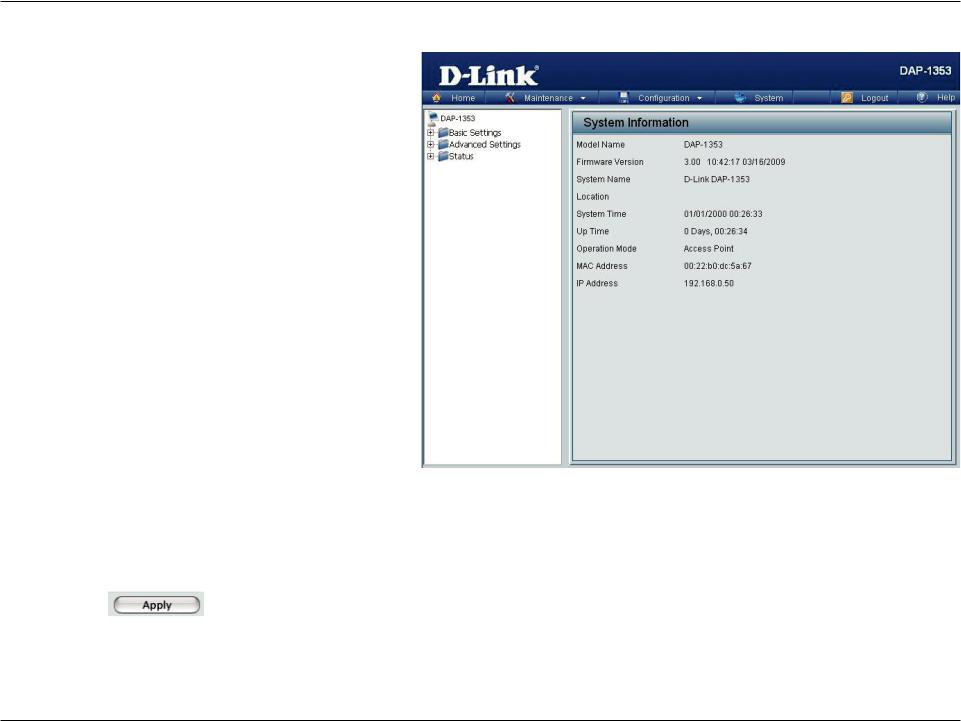
Section 3 - Configuration
After successfully logging into the DAP-1353 the following screen will appear:
When making changes on most of the configuration screens in this section, use the Apply button at the bottom of each screen to save your configuration changes.
Click the Apply button to configure changes.
D-Link DAP-1353 User Manual |
15 |
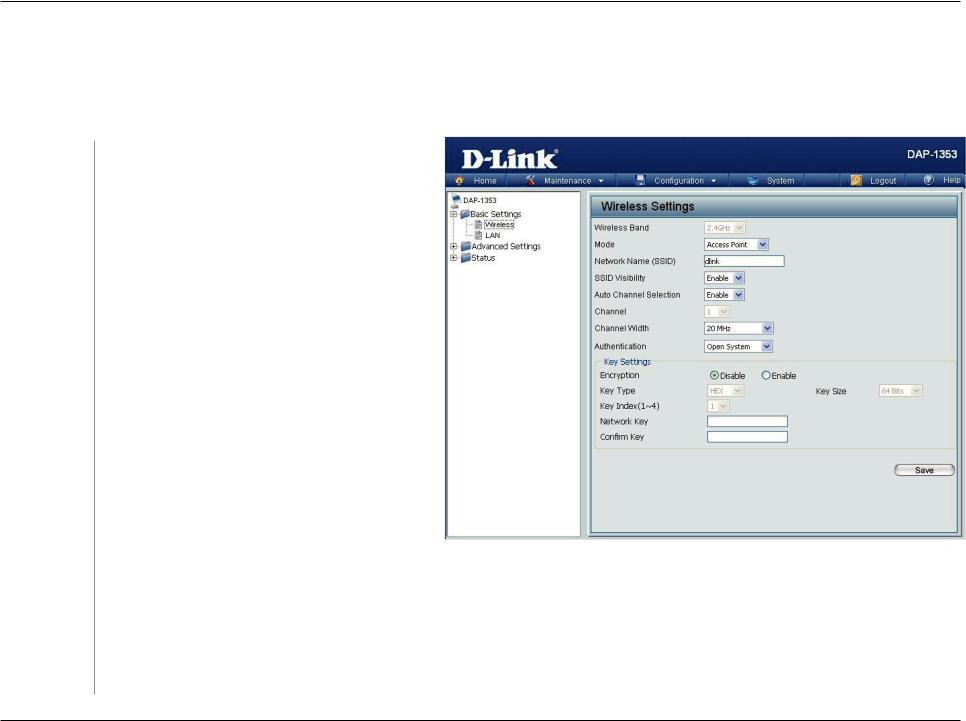
Section 3 - Configuration
Home > Basic Settings
Wireless
Access Point mode
Wireless Band: 2.4 GHz
Mode: Select Access Point from the pull-down menu.
The other three choices are WDS with AP,
WDS, and Wireless Client.
Network Name Service Set Identifier (SSID) is the name (SSID): designated for a specific wireless local area
network (WLAN). The SSID’s factory default setting is dlink.TheSSIDcanbeeasilychanged to connect to an existing wireless network or to establish a new wireless network. The SSID can be up to 32 characters and is case-sensitive.
SSID Visibility: Enable or Disable SSID visibility. Enabling this featurebroadcaststheSSIDacrossthenetwork, thus making it visible to all network users.
Auto Channel Enabling this feature automatically selects Selection: the channel that provides the best wireless
performance. Enable is set by default. The channel selection process only occurs when the
AP is booting up.
Channel: All devices on the network must share the same channel. To change the channel, first toggle the Auto Channel Selection setting to Disable, and then use the pull-down menu to make the desired selection.
Note: The wireless adapters will automatically scan and match the wireless settings.
D-Link DAP-1353 User Manual |
16 |

Section 3 - Configuration
Channel Width: Allows you to select the channel width you would like to operate in. Select 20 MHz if you are not using any 802.11n wireless clients. Auto 20/40 MHz allows you to connect to both 802.11n and 802.11b/g wireless devices on your network.
Authentication: Use the pull-down menu to choose Open System, Shared Key, WPA-Personal, or WPA-Enterprise. Select Open System to communicate the key across the network.
Select Shared Key to limit communication to only those devices that share the same WEP settings. If multi-SSID is enabled, this option is not available.
Select WPA-Personal to secure your network using a password and dynamic key changes. No RADIUS server is required.
Select WPA-Enterprise to secure your network with the inclusion of a RADIUS server.
D-Link DAP-1353 User Manual |
17 |

Section 3 - Configuration
WDS with AP mode
In WDS with AP mode, the DAP-1353 wirelessly connects multiple networks while still functioning as a wireless AP.
Wireless Band: 2.4GHz.
Mode: WDS with AP mode is selected from the pull-down menu.
Network Name ServiceSetIdentifier(SSID)isthenamedesignatedfora (SSID): specific wireless local area network (WLAN). The SSID’s factory default setting is dlink. The SSID can be easily changed to connect to an existing wireless network or to
establish a new wireless network.
SSID Visibility: Enable or Disable SSID visibility. Enabling this feature broadcasts the SSID across the network, thus making it visible to all network users.
Auto Channel Enabling this feature automatically selects the channel Selection: that will provide the best wireless performance. This feature is not supported in WDS with AP mode. The channel selection process only occurs when the AP is
booting up.
Channel: All devices on the network must share the same channel. To change the channel, use the pull-down menu to make the desired selection. (Note: The wireless adapters will automatically scan and match the wireless settings.)
Channel Width: Allows you to select the channel width you would like to operate in. Select 20 MHz if you are not using any 802.11n wireless clients. Auto 20/40 MHz allows you to connect to both 802.11n and 802.11b/g wireless devices on your network.
D-Link DAP-1353 User Manual |
18 |

Section 3 - Configuration
Remote AP MAC
Address:
Site Survey:
Authentication:
Enter the MAC addresses of the APs on your network that will serve as bridges to wirelessly connect multiple networks.
Click on the Scan button to search for available wireless networks, then click on the available network that you want to connect with.
Use the pull-down menu to choose Open System, Shared Key, or WPA-Personal. Select Open System to communicate the key across the network.
Select Shared Key to limit communication to only those devices that share the same WEP settings. If multi-SSID is enabled, this option is not available.
Select WPA-Personal to secure your network using a password and dynamic key changes. No RADIUS server is required.
D-Link DAP-1353 User Manual |
19 |

Section 3 - Configuration
WDS mode
In WDS mode, the DAP-1353 wirelessly connects multiple networks, without functioning as a wireless AP.
Wireless Band: 2.4GHz.
Mode: WDS is selected from the pull-down menu.
Network Name Service Set Identifier (SSID) is the name
(SSID): designated for a specific wireless local area network (WLAN). The SSID’s factory default setting is dlink. The SSID can be easily changed to connect to an existing wireless network or to establish a new wireless network.
SSID Visibility: Enable or Disable SSID visibility. Enabling this feature broadcasts the SSID across the network, thus making it visible to all network users.
Auto Channel Enabling this feature automatically selects Selection: the channel that will provide the best wireless performance. This feature is not supported in
WDS mode.
Channel: All devices on the network must share the same channel. To change the channel, use the pull-down menu to make the desired selection.
Channel Width: Use the pull-down menu to choose 20 MHz or Auto 20/40 MHz.
Remote AP MAC Enter the MAC addresses of the APs on your network that will serve as bridges to wirelessly connect multiple networks.
Address:
D-Link DAP-1353 User Manual |
20 |

Section 3 - Configuration
Site Survey:
Authentication:
Click on the Scan button to search for available wireless networks, then click on the available network that you want to connect with.
Use the pull-down menu to choose Open System, Shared Key, or WPA-Personal. Select Open System to communicate the key across the network.
Select Shared Key to limit communication to only those devices that share the same WEP settings.
Select WPA-Personal to secure your network using a password and dynamic key changes. No RADIUS server is required.
D-Link DAP-1353 User Manual |
21 |
